
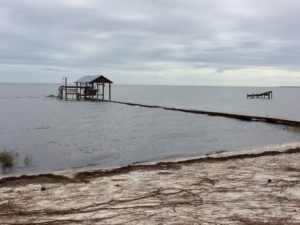
King tide showed its muscle on the Hunter Moon.
Last weekend, a series of impressive king tides, swelled by the full moon, rose our Gulf waters a foot or more higher above normal. In south Florida, sea water ran deep in the streets. But along our lightly populated coast, I noticed only submerged docks, from Lanark to Eastpoint.
On St. Vincent Island, the king tides carved two long swales and filled them with salt Gulf water. The pool closer to the dunes was deeper, and had apparently entrapped an active school of splashing fish. Or so I thought.
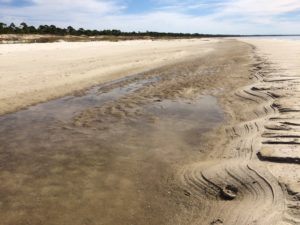
The king tide carved this swale in the sand, and then withdrew to normal levels.
But five nights later, I walked along those same pools with my husband Jeff, and the evening angle of the sun revealed a dozen small stingrays thrashing in the upper pond.
Jeff pointed out the deep sculpting of the sand, how the unusually high waters had permanently stranded the pool and its inhabitants from the Gulf.
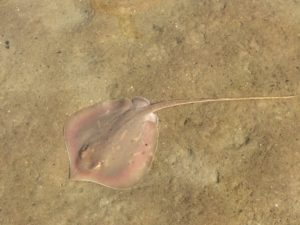
A sad ray
Each of these animals was about the diameter of a sun hat, and when we approached, they buried themselves in the sand.
Here’s a close up of one. You can see that if ever a sea creature felt worried and hopeless, this one certainly did.
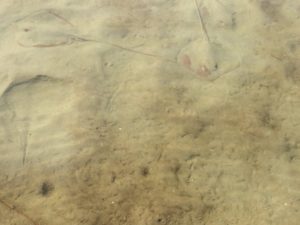
Stingrays are so hard to see. Always shuffle your feet in shallow water!
And with good reason. The fate that awaited them in their dwindling pool was slow death by either starvation, heat stress, or desiccation. If you read my book Coming to Pass: Florida’s Coastal Islands in a Gulf of Change, then you might remember my fondness for stingrays (see page 67-68).

We determined to rescue them the next morning. Our friend Chris produced three long handled nets, and at daybreak we were off, skimming over the Pass in our powerboat to the front beach of the island.
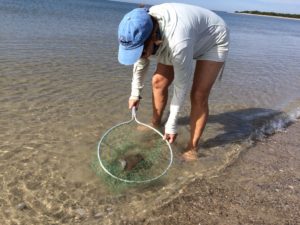
Much as I love these rays, I didn’t want to chance a barb in my fingers.
It isn’t often we are able to positively intervene in the fate of wild creatures, especially as more and more are affected by climate change and extreme weather events. What a privilege, then, to extend the lives of eleven beautiful animals!
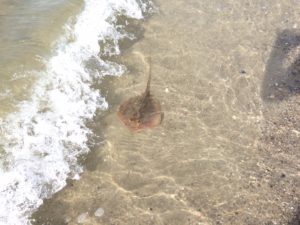
Live long and prosper, little ray!

Great post, Sue. And way to go! Heroes for the rays.
You are a great example to follow
Beautiful experience. Thanks for sharing.
Good story but those aren’t cow-nosed rays (Rhinoptera bonasus) unless it is a local common name that I am unaware of. They look like Atlantic stingrays (Dasyatis sabina) to me.
Great post. The king tides overwashed the western narrows of Dog Island, concentrating little pockets of resting shorebird migrants high up in the duneline in places where they usually avoid. And thanks for rescuing the cow-nosed rays—they accompany me on my shorebird surveys on clear-water days, always feeding right up next to shore; maybe they think I ‘m just a great blue heron wading along with them. Their grey/rose colors are very pretty.
Thanks for the correction, Chris!
Beautiful, Mike!
Thanks, Sandy. I know you do stuff like this all the time….
Thank you for your kind words, Carole.
Thanks, Davey.
Thank you for saving them!! I greatly appreciate what you did for the rays.
Thanks for this heart-warming and informative story, Sue, and for the efforts you and Jeff made on behalf of the rays!
The best I’ve felt in a long time during the weary, scary election. A joy to know 16 rays live to sting another day.
Awww, Karla, Ana, Elizabeth….we did it for all of us, as you would have, too.